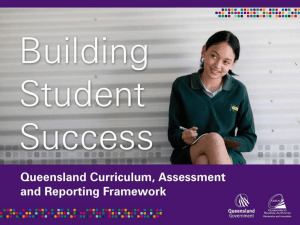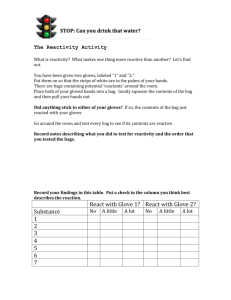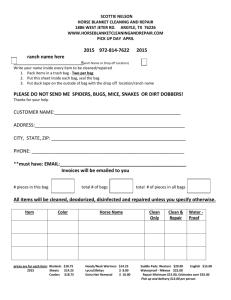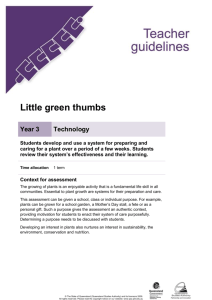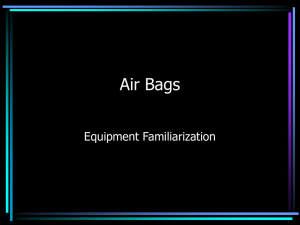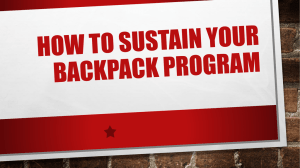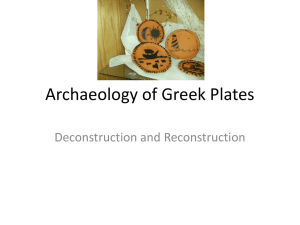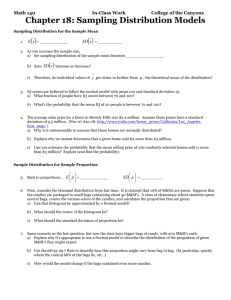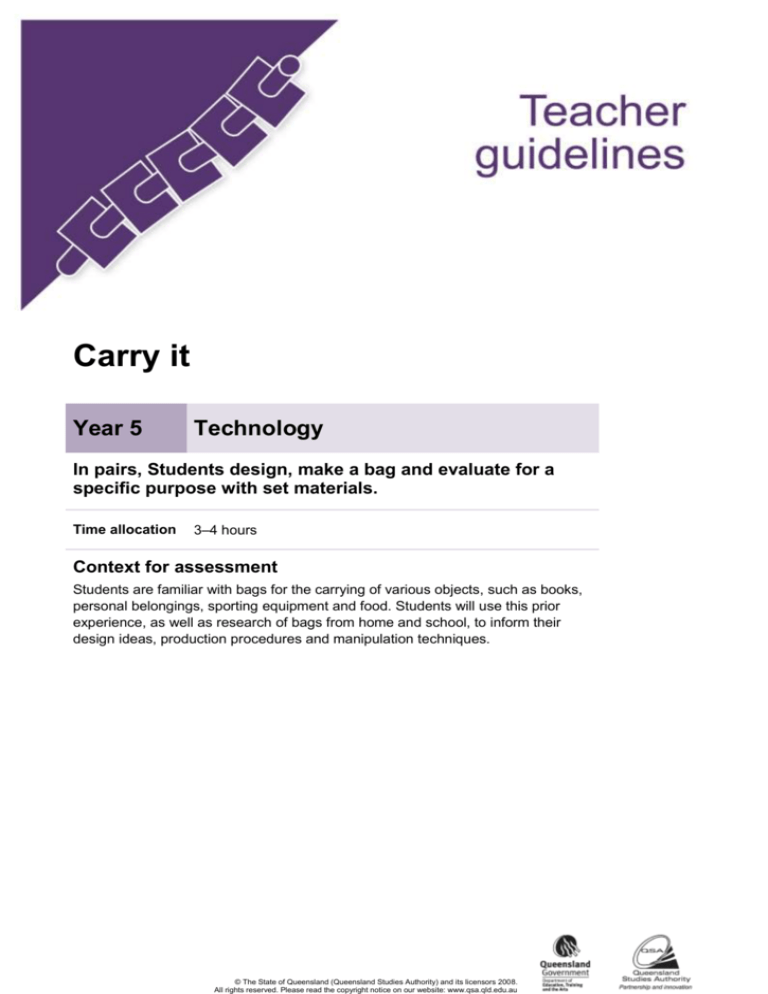
Carry it
Year 5
Technology
In pairs, Students design, make a bag and evaluate for a
specific purpose with set materials.
Time allocation
3–4 hours
Context for assessment
Students are familiar with bags for the carrying of various objects, such as books,
personal belongings, sporting equipment and food. Students will use this prior
experience, as well as research of bags from home and school, to inform their
design ideas, production procedures and manipulation techniques.
© The State of Queensland (Queensland Studies Authority) and its licensors 2008.
All rights reserved. Please read the copyright notice on our website: www.qsa.qld.edu.au
Teacher guidelines
This assessment gathers evidence of learning for the following Essential Learnings.
Technology
Essential Learnings by the end of Year 5
Ways of working
Knowledge and understanding
Students are able to:
Technology as a human endeavour
identify and analyse the purpose and
context for design ideas
Technology influences and impacts on people,
their communities and environments.
generate design ideas that match
requirements
select resources, techniques and
tools to make products
Different ideas for designs and products are
developed to meet the needs and wants of
people, their communities and environments.
plan production procedures by
identifying and sequencing steps
Aspects of appropriateness influence product
design and production decisions.
Information, materials and systems (resources)
make products to match design ideas
by manipulating and processing
resources
The characteristics of resources are matched
with tools and techniques to make products to
meet design challenges.
identify and apply safe practices
evaluate products and processes to
identify strengths, limitations,
effectiveness and improvements
reflect on learning to identify new
understandings and future
applications.
Techniques and tools are selected to
appropriately manipulate characteristics of
resources to meet design ideas.
Assessable elements
Knowledge and understanding
Investigating and designing
Producing
Evaluating
Reflecting
Source: Queensland Studies Authority 2007, Technology Essential Learnings by the end of Year 5, QSA, Brisbane.
Links to other KLAs
This assessment could be expanded to assess the following Essential Learnings.
2
Year 5 Technology: Carry it
Mathematics
Essential Learnings by the end of Year 5
Ways of working
Knowledge and understanding
Students are able to:
Measurement
identify and describe the
mathematical concepts, strategies
and procedures required to generate
solutions
Length area, volume, mass, time and angles can
be estimated, measured and ordered, using
standard and non-standard units of measure.
reflect on mathematics and identify
the contribution of mathematics to
personal activities.
Standard units, including centimetre, metre,
square centimetre, square metre, gram,
kilogram, minute, degree, millilitre and litre, and
a range of instruments are used to measure and
order attributes of objects, including length,
area, volume, mass, time and angles.
Source: Queensland Studies Authority 2007, Mathematics Essential Learnings by the end of Year 5, QSA, Brisbane.
Listed here are suggested learning experiences for students before attempting this assessment.
Research and examine different types of bags, looking at size, shape, materials, joins and
decorative elements.
Examine properties and manipulation techniques of a variety of natural and man-made
materials.
Use tools correctly and safely (e.g. scissors, glue gun, stapler, needle and thread). For safety
guidelines see Teacher resources.
Become familiar with reflection processes — what reflection is, how to reflect and why
reflection is important.
Practise writing procedural texts (e.g. recipes, instructions).
Share strengths and limitations of own and peer work appropriately.
Develop skills for working collaboratively (e.g. taking turns, making decisions, sharing workload
and conflict resolution).
Experiment with procedures to test effectiveness (e.g. why should products be tested and how
testing can occur).
Teacher resources
3
Teacher guidelines
Technology (2003) sourcebook guidelines (PDF) contains comprehensive safety guidelines in
Appendix B. This document can be found on the Queensland Studies Authority website at:
<http://www.qsa.qld.edu.au/syllabus/842.html>.
Department of Education Manual contains instructions on safety practices in the classroom.
Available to EQ schools only at: <http://education.qld.gov.au/corporate/doem>.
Workplace Health and Safety Act 1995 (PDF) is available on the Department of Employment and
Industrial Relations website at: <http://www.deir.qld.gov.au/workplace/law/index.htm>.
Preparing
Consider these points before implementing the assessment.
Students work in pairs to design and make a bag. Teachers may allocate partners or allow
students to choose their partners. Please note that not all students may feel comfortable
having to choose partners.
Ensure that there are sufficient resources available to make the bags, including staplers and
other tools that all pairs may want to use simultaneously.
If tools are minimal in number then consider group rotation.
Group rotation may also help in assessing individual contributions to the design and production
of the bag.
Be aware of safety considerations such as the storage and use of scissors, staplers, glue,
needles, etc. For safety guidelines see Teacher resources.
Possible extension activities
This assessment could be extended to cover the following:
How strong are the bags or baskets? Test using weights.
Weather proofing the bags or baskets.
4
Year 5 Technology: Carry it
Sample implementation plan
This table shows one way that this assessment can be implemented. It is a guide only — you may
choose to use all, part, or none of the table. You may customise the table to suit your students and
their school environment.
Suggested time
Student activity
Teacher role
Section 1. Design a bag
30 minutes
1–2 hours
Read and understand
design brief.
Read and explain instructions to students.
Collect materials and
tools.
Assist in organising student pairs and material
selection.
Generate design ideas
with a partner.
Discuss with students their individual
contributions and observe their work, to assist in
making accurate judgements.
Put together a production
plan and make a bag with
a partner.
Encourage students to take their time with their
planning. The Student booklet provides a
template for this process, but students may
prefer to use large sheets of paper to initially
brainstorm ideas.
All students need to
discuss, draw, seek
feedback and consider
alternatives as part of
their planning process.
Model how to plan a design.
Ensure that students have completed their plan
and have the necessary resources before
making their bag.
Section 2. Make a bag
30 minutes
Students write instructions
on how to make the bag.
Ensure that there are enough materials
available.
You may wish to have students make their bags
in cluster groups rather then as a whole class.
It may take a couple of sessions for students to
complete the bag.
Section 3. Reflection
30 minutes
5
Students individually
complete an evaluation.
Read and clarify questions.
Teacher guidelines
Resources for the assessment
Each pair will choose one of the following materials lists.
Teachers may wish to modify the selection of resources to suit their school context and will need to
ask students to provide some of the set resources for their bag.
Choice 1: Materials list
Choice 2: Materials list
one weekday newspaper or 10 plastic
shopping bags
two items of old clothing (e.g. jeans,
shirt — adult or child sizes)
stapler, hobby glue or adhesive, needle,
thread
stapler, hobby glue or adhesive, needle,
thread
scissors
scissors
1 cardboard or vinyl strip 100 cm x 4 cm
two shoe laces (optional)
paint, brushes (optional).
paint, brushes (optional).
Sample bags
6
Year 5 Technology: Carry it
During the learning process, you and your students should have developed a shared
understanding of the curriculum expectations identified as part of the planning process.
After students have completed the assessment, identify, gather and interpret the information
provided in student responses. Use only the evidence in student responses to make your judgment
about the quality of the student learning. Refer to the following documents to assist you in making
standards-referenced judgments:
Guide to making judgments
Indicative A response
Sample responses (where available).
Making judgments about this assessment
The assessment of individual contributions within a group assessment must include:
direct observation of students working in the group
close analysis of individual work sheets
discussion with each pair as to how they worked together, who did what within the assessment
and why that allocation was made.
For further information, refer to the resource Using a Guide to making judgments,
available in the Resources section of the Assessment Bank website.
Evaluate the information gathered from the assessment to inform teaching and learning strategies.
Involve students in the feedback process. Give students opportunities to ask follow-up questions
and share their learning observations or experiences.
Focus feedback on the student’s personal progress. Emphasise continuous progress relative to
their previous achievement and to the learning expectations — avoid comparing a student with
their classmates.
For further information, refer to the resource Using feedback, available in the
Resources section of the Assessment Bank website.
7

